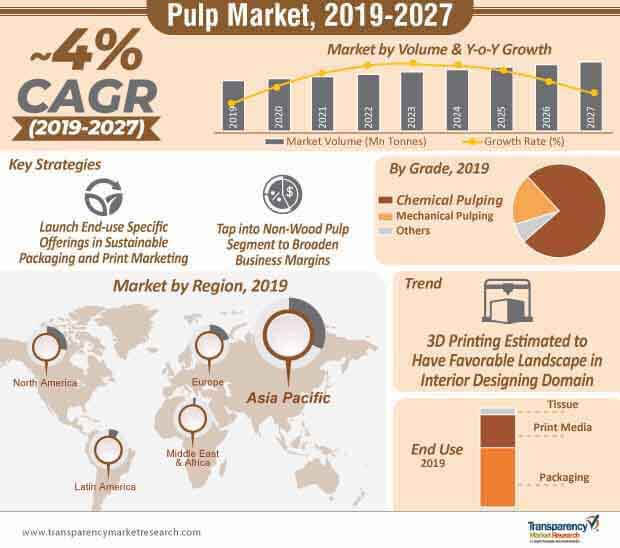
Transparency Market Research delivers key insights on the global pulp market in its published report, which includes global industry analysis, size, share, growth, trends, and forecast for the period of 2019–2027. In terms of revenue, the global pulp market is estimated to expand at a CAGR of ~ 4% during the forecast period, owing to numerous factors, about which, TMR offers thorough insights and forecast in this report.
Pulp Market: An Overview
Pulp is basically made from the fibrous part of plants, mostly trees, and is the prime ingredient in the process of papermaking. Pulp is usually sourced from wood, non-wood, and recycled pulp. Recovered paper made by removing inks and other contaminants is the medium through which recycled/de-inked pulp is extracted. The global push for the use of sustainable materials is expected to aid the growth in the demand for recycled pulp. Among the end uses, the increasing use of paper-based packaging formats is expected to be the prominent driver for the growth of the global pulp market.
Planning To Lay Down Future Strategy? Request Sample https://www.transparencymarketresearch.com/sample/sample.php?flag=S&rep_id=40241
East Asian Economies hold Lucrative Opportunities for Pulp Manufacturers
Asia Pacific, in terms of pulp production, holds ~ 45% of the global market share, and is expected to uphold its lead over the forecast period. China tops the charts for both, the production as well as consumption of pulp. The market for pulp in Japan is projected to continue its prominence, owing to its sharp shift towards greener packaging solutions, in which, corrugated and Kraft paper companies have a better development prospect. Also, the average operating income of pulp manufacturers based in the Asia Pacific region presents an upward trend. However, this region houses many unorganized and small-scale manufacturers, which might not compete with tier-1 pulp producers directly, but can impact the local pricing to some extent. Thus, the Asian pulp market can be considered as a highly competitive market, and promises to offer lucrative opportunities.
While North America is still the largest wood pulp producer, followed by Europe, new pulp milling facilities are being created in South America (especially Brazil), Russia, Asia (Indonesia), and Northern Europe. The United States represents ~ 85% of the pulp market in North America, while Canada is expected to expand at a high CAGR during the forecast period. Moreover, a large number of tier-1 & tier-2 pulp companies are based in North America.
Curious? Request To Access Market Data Pulp Market
Pulp Market: Competition Landscape
In the global market report for pulp, the competition landscape is discussed. Key players profiled in the pulp market are Westrock Company, International Paper, Stora Enso Pulp AB, Georgia-Pacific Corp., Kimberly-Clark Corp., Oji Holdings Corporation., Nippon Paper Group, Asia Pulp and Paper Group, UPM, Nordic Paper Holding AB, Mercer International Group, Metsä Board Corporation, BillerudKorsnäs AB, Nine Dragons Paper Limited, Sappi Group, Rama Pulp and Papers Limited, Gulf Paper Manufacturing Company, Nisseysangyo Co., Ltd., Canny Tissue Paper Industry (L.L.C), and Metropolic Paper Industries Inc.
More Trending Reports by Transparency Market Research –
Comments
Post a Comment